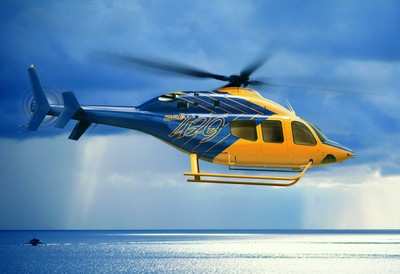Wed, Sep 08, 2010
System Approved For 9 Degree LPV Approaches At 45 knots
The FAA has certified Bell Helicopter's precision Wide Area
Augmentation System (WAAS) enabled glide path capability on the
Bell 429. The aircraft is the only helicopter available with
technology certified for 9 degree localizer precision with vertical
guidance (LPV) approaches at a minimum velocity for instrument
procedures (Vmini) of 45 knots. Such a low minimum velocity
allows for the Bell 429 to fly LPV procedures in steep approach
conditions.

Using a modernized cockpit layout and navigation solutions the
Bell WAAS capability, as demonstrated on the Bell 429, increases
helicopter safety, mission efficiency and environmental
sensitivity, while reducing precision approach limitations and
associated operational costs. Many flights are grounded annually
due to poor weather conditions, the WAAS capability allows for
point-in-space approaches as low as 250 foot visibility.
Bell's 429 WAAS implementation changes the helicopter operating
environment, allowing for the creation of a safer rotorcraft IFR
system, providing a platform to put those capabilities to use and
allowing for precision approaches in low altitude, urban areas.
Designed, developed, implemented and tested by a government
industry partnership, the continuing airspace infrastructure
project will facilitate the creation of public use rotorcraft
solutions and provide a solid framework for additional next
generation national airspace developments. Along with Bell, the
team includes the Federal Aviation FAA's Global Navigation
Satellite System (GNSS) Program Office, the FAA Flight Standards
Organization, Hickok and Associates, Air Methods Corporation, and
the Mercy Medical Team.

"It is because of this collaboration we are able to provide the
helicopter industry and our customers with innovative solutions
that exceed their mission requirements," said Nick Lappos, Bell
Helicopter chief technology officer. "It is only fitting that this
capability be available exclusively on the world's most advanced
light twin helicopter, the 429."
This technology is available immediately on all new Bell 429s
delivered out of the Bell Helicopter Mirabel, Canada facility. Bell
Helicopter is exploring the use of this technology on additional
Bell aircraft. "WAAS technologies, when combined with the 429,
provide all operators engaged in IFR operations a vehicle to
complete missions that were unthinkable in the past. This total
aircraft solution will increase the number of missions that are
flown and ultimately save more lives," said Roberts.
More News
Aero Linx: International Federation of Airworthiness (IFA) We aim to be the most internationally respected independent authority on the subject of Airworthiness. IFA uniquely combi>[...]
Ultrahigh Frequency (UHF) The frequency band between 300 and 3,000 MHz. The bank of radio frequencies used for military air/ground voice communications. In some instances this may >[...]
A Few Questions AND Answers To Help You Get MORE Out of ANN! 1) I forgot my password. How do I find it? 1) Easy... click here and give us your e-mail address--we'll send it to you >[...]
From 2019 (YouTube Edition): Learning To Paint Without Getting Any On Your Hands PPG's Aerospace Coatings Academy is a tool designed to teach everything one needs to know about all>[...]
Also: Sustainable Aircraft Test Put Aside, More Falcon 9 Ops, Wyoming ANG Rescue, Oreo Cookie Into Orbit Joby Aviation has reason to celebrate, recently completing its first full t>[...]
 ANN's Daily Aero-Linx (05.06.25)
ANN's Daily Aero-Linx (05.06.25) ANN's Daily Aero-Term (05.06.25): Ultrahigh Frequency (UHF)
ANN's Daily Aero-Term (05.06.25): Ultrahigh Frequency (UHF) ANN FAQ: Q&A 101
ANN FAQ: Q&A 101 Classic Aero-TV: Virtual Reality Painting--PPG Leverages Technology for Training
Classic Aero-TV: Virtual Reality Painting--PPG Leverages Technology for Training Airborne 05.02.25: Joby Crewed Milestone, Diamond Club, Canadian Pilot Insurance
Airborne 05.02.25: Joby Crewed Milestone, Diamond Club, Canadian Pilot Insurance




